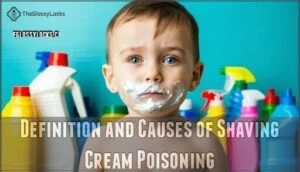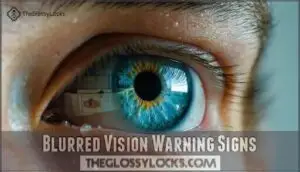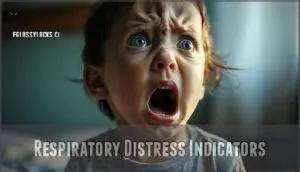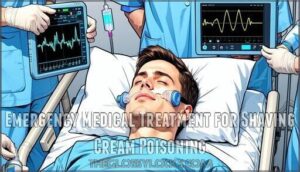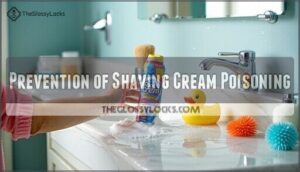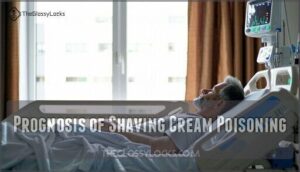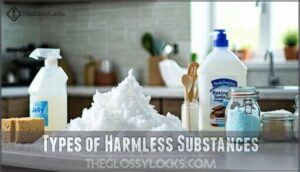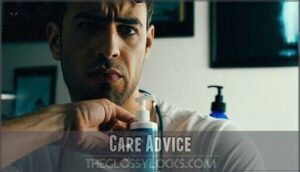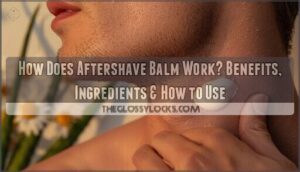This site is supported by our readers. We may earn a commission, at no cost to you, if you purchase through links.

Don’t panic, rinse your mouth and drink water or milk to dilute it.
You’ll want to know what to do next to minimize the discomfort. The good news is that it’s usually not serious, but to safeguard your well-being, take the right steps.
You’ll find more information on how to handle this situation and what to expect in the next section, where we’ll explore the details of shaving cream poisoning and the best course of action.
Table Of Contents
- Key Takeaways
- What Happens if You Eat Shaving Cream & What to Do?
- Definition and Causes of Shaving Cream Poisoning
- Signs and Symptoms of Shaving Cream Poisoning
- First Aid for Shaving Cream Poisoning
- Emergency Medical Treatment for Shaving Cream Poisoning
- Prevention of Shaving Cream Poisoning
- Prognosis of Shaving Cream Poisoning
- Types of Harmless Substances
- When to Call for Swallowed Harmless Substance
- Care Advice
- Frequently Asked Questions (FAQs)
- What happens if you eat shaving cream?
- What is shaving cream poisoning?
- What should I do if someone eats shaving cream?
- What if a person swallowed shaving cream?
- What should I do if I have a shave cream toxicity?
- What happens if a child eats shaving cream?
- What to do if you eat shaving cream?
- What happens if you accidentally eat hair removal cream?
- What happens if you accidentally eat cream?
- What are the side effects of shaving cream?
- Conclusion
Key Takeaways
- If you eat shaving cream, you’ll likely experience stomach pain, vomiting, and diarrhea due to the chemicals and surfactants, so it’s crucial to rinse your mouth and drink water or milk to dilute it.
- You should contact Poison Control immediately if you or someone else swallows shaving cream, and follow their guidance for treatment and care to minimize potential toxicity effects.
- It’s essential to monitor for symptoms like stomach pain, vomiting, or difficulty breathing, and if severe reactions occur, you should seek medical help right away to prevent further complications.
- To prevent accidents, you should keep personal care products out of reach of children and pets, use them as directed, and stay informed about potential risks when handling household items to ensure your safety and the safety of those around you.
What Happens if You Eat Shaving Cream & What to Do?
If you’ve accidentally eaten shaving cream, don’t panic—it’s usually not life-threatening if only a small amount is swallowed.
Stay calm if you swallow shaving cream, it’s usually not life-threatening in small amounts
Most shaving creams contain mild toxins, so you might experience nausea, vomiting, or a burning sensation in your mouth or throat.
Bigger amounts, however, could cause more severe symptoms like abdominal pain or difficulty breathing.
To stay safe, rinse your mouth with water and sip milk or water if swallowing isn’t a challenge.
Avoid inducing vomiting—it can make things worse.
Contact Poison Control (1-800-222-1222) for advice suited to the situation.
Keep an eye out for worsening symptoms, as post-ingestion monitoring is important to catch any long-term complications.
Remember, shaving cream ingestion is serious but manageable with the right steps!
Definition and Causes of Shaving Cream Poisoning
Shaving cream poisoning happens when you swallow or come into contact with harmful ingredients like surfactants and chemicals used in the product.
It’s often accidental, especially with kids, but knowing the causes can help prevent it.
Ingredients and Composition
Shaving cream ingredients sound innocent but pack a mix of chemicals.
Key components include:
- Surfactant types: Help foam and cleanse but may irritate skin.
- Emulsified oils: Add moisture yet could bother sensitive users.
- Hazardous chemicals: Parabens, aerosol propellants, and triethanolamine improve functionality in cosmetic products but raise health concerns if ingested.
Modern shaving creams often use stearic acid as a key ingredient.
Always use shaving cream cautiously!
Common Exposure Scenarios
Curious kids often mistake foamy products for something edible, leading to accidental ingestion. Pets might lick dropped cream, and improper storage invites risks.
Adults sometimes misuse it, like inhaling or overapplying. If your child ate shaving cream or there’s suspected shaving cream ingestion, act swiftly to address the situation.
| Scenario | Common Cause |
|---|---|
| Child access | Left unlabeled |
| Pet exposure | Dropped cream |
| Improper storage | Unsecured cabinets |
| Shaving cream misuse | Inhalation |
| Ingestion from objects | Contaminated toys |
The table outlines various scenarios related to shaving cream, including child access, pet exposure, and improper storage, which can lead to risks such as shaving cream misuse.
Potential Health Risks
Ingestion hazards from shaving cream include skin irritation, chemical burns, and allergic reactions.
Shaving cream poisoning can lead to symptoms like blurred vision, breathing trouble, or stomach pain.
Certain ingredients may even cause hormone disruption. While small amounts are usually harmless, larger quantities bring risks like gastrointestinal issues and burns.
If a child ingests shaving cream, remember that eye contact may sting. Recognize symptoms of ingestion quickly, act fast, and stay safe!
Signs and Symptoms of Shaving Cream Poisoning
If you accidentally eat shaving cream, your body might react with symptoms like nausea, vomiting, or throat irritation.
It’s important to recognize these signs quickly and know what steps to take next, which can be crucial in addressing the symptoms.
Blurred Vision Warning Signs
Blurred vision is one of the symptoms of shaving cream poisoning, often hinting at eye irritation or more severe problems.
Watch for these warning signs:
- Redness and irritation: Eyes feeling itchy or watery.
- Burning pain: A sharp, stinging sensation.
- Trouble seeing clearly: Vision changes like blurriness.
- Possible damage: Chemicals like potassium hydroxide may cause long-term harm.
Seek medical help promptly!
Respiratory Distress Indicators
Struggling to catch your breath? Watch for respiratory distress signs like wheezing sounds, nasal flaring, and a fast breathing rate.
Chest retractions or a bluish tint (cyanosis) around lips are red flags. If breathing difficulty worsens, it’s an emergency—seek assistance immediately.
Breathing difficulties, especially with chest tightness, shouldn’t be ignored. Stay alert, and act quickly when needed, as respiratory distress signs can indicate a serious issue.
Gastrointestinal Symptom Alerts
If shaving cream poisoning happens, look out for these gastrointestinal issues:
- Abdominal Pain: Persistent, sharp discomfort is a warning sign.
- Vomiting Risks: Repeated vomiting, sometimes bloody, can occur quickly or hours later.
- Diarrhea Alert: Watery or bloody diarrhea often signals trouble.
Don’t wait—call poison control immediately if these symptoms appear. Acting fast makes all the difference!
First Aid for Shaving Cream Poisoning
If you or someone else swallows shaving cream, acting quickly can help prevent complications.
Start by ensuring the airway is clear and providing small sips of water or milk if there’s no trouble swallowing.
Protect Airway
If breathing difficulty strikes, focus on the airway obstruction. Verify clear passage by gently tilting their head and checking for choking hazards.
Avoid inducing vomiting—it increases the aspiration pneumonia risk. Minimize respiratory distress with calm reassurances, and call emergency assistance immediately.
Here’s a quick guide:
| Symptom | Action |
|---|---|
| Choking hazards | Check for blockage |
| Vomiting risk | Avoid inducing |
| Breathing difficulties | Call 911 |
| Emergency response | Seek immediate aid |
Wash Eyes
If shaving cream gets into your eyes, act fast to prevent chemical burns and irritation.
Follow these steps:
- Flush Duration: Rinse your eyes with lukewarm water for at least 15 minutes.
- Irrigation Techniques: Keep your eyelids open while rinsing.
- Avoid Rubbing: This can worsen eye burns or irritation.
For enhanced safety, consider using sterile eye irrigants.
- Vision Assessment: Check for blurred vision or redness, and seek follow-up care if needed.
Provide Liquid Intake
After rinsing your eyes, focus on hydration.
Offer small sips of water or milk (no soda or juice), ensuring swallowing isn’t difficult.
Fluids help dilute shaving cream poisoning effects, so avoid warm drinks or harmful items.
Stick to safe options.
It’s important to note that milk can be used for certain types of poisoning.
If swallowing’s tricky, skip fluids entirely.
For accidental ingestion, contact poison control right away for guidance on what to do now.
Emergency Medical Treatment for Shaving Cream Poisoning
If you’ve swallowed shaving cream or suspect someone has, it’s important to seek medical help right away.
Seek medical help immediately if shaving cream is swallowed
Emergency treatment focuses on managing symptoms, ensuring proper breathing, and preventing further complications.
Manage Symptoms
When handling shaving cream poisoning, addressing symptoms quickly is key.
Keep an eye on essential signs and comfort levels. Treatments can include IV fluids, laxatives, or medications to ease issues like vomiting or abdominal pain.
- Monitor for symptom severity, including pain or irritation.
- Treat burns in the mouth or throat to reduce irritation.
- Ensure prompt pain relief for overall recovery.
Provide Breathing Support
If you’re dealing with breathing difficulties from ingesting shaving cream, swift action is critical.
Emergency assistance often includes assisted ventilation, oxygen delivery, or even ventilator usage for severe cases.
Airway management guarantees proper oxygen flow, especially during respiratory distress.
These situations may require specialized assisted breathing apparatus.
Emergency treatment teams monitor breathing and signs, keeping everything under control while stabilizing your condition efficiently with the help of assisted ventilation.
Eye Care
If shaving cream gets in your eyes, an Eye Wash is your first line of defense.
Rinse with lukewarm water for 15 minutes to ease the burning sensation and prevent Chemical Burns.
Remove contact lenses immediately.
Persistent eye irritation or blurred vision?
Seek emergency assistance for proper First Aid.
Protect your Vision Recovery with these steps:
- Flush eyes gently but thoroughly.
- Use soothing, over-the-counter eye drops.
- Call a doctor if discomfort lingers.
Administer Laxatives and IV Fluids
Doctors may use laxatives and IV fluids if you’ve ingested too much shaving cream.
These help flush harmful substances and maintain fluid balance.
Your medical team carefully monitors:
- Side effects like dehydration risks.
- Your body’s progress to guarantee steady recovery.
- Doses of laxatives based on your condition.
- Long-term effects to prevent complications.
Always seek medical help promptly.
Prevention of Shaving Cream Poisoning
You can prevent shaving cream poisoning by keeping it out of reach of children and pets and always using it as directed.
Take a second to read the label—it’s an easy way to avoid accidents and stay safe.
Usage Instructions
Always stick to the recommended amount when using shaving cream to avoid accidental ingestion.
Read the label for Safe Application tips. Keep it stored securely, using Childproof Measures for families.
Here’s a helpful guide:
| Key Step | Why It Matters | Quick Tip |
|---|---|---|
| Use Properly | Reduces accidents | Follow instructions |
| Check Labels | Know product risks | Look for safety warnings |
| Use Safely | Prevents ingestion | Avoid excessive amounts |
| Store Securely | Protects loved ones | Keep out of children’s reach |
Following these steps avoids unnecessary calls to poison control.
Keep Products Out of Reach
Curiosity drives kids (and pets!) to explore, so prevention is key.
Keep shaving cream safe with simple steps:
- Childproof containers or high, locked cabinets.
- Supervise children during grooming time.
- Use clear labels to avoid mix-ups.
Secure storage and childproofing keep little hands and paws away, helping you avoid accidental ingestion and ensuring a safer home for everyone.
Awareness of First Aid Steps
You should know first aid steps for shaving cream poisoning.
If exposed, wash eyes with water and give fluid intake unless swallowing is difficult.
Airway protection is key, then seek medical assistance and contact poison control for proper ingestion treatment and emergency treatment guidance.
Prognosis of Shaving Cream Poisoning
When you’ve ingested shaving cream, your prognosis is generally good with prompt treatment.
Here’s what you can expect:
- Minor exposures often resolve within hours or days.
- Significant ingestions may require intensive treatment.
- Older adults or those with pre-existing conditions are at higher risk.
- With proper care, most individuals recover completely.
Recovery likelihood depends on treatment impact, severity factors, and monitoring key signs. Fortunately, long-term effects are uncommon, and shaving cream poisoning prognosis is favorable with medical attention.
Types of Harmless Substances
You’re likely curious about what substances are harmless if ingested, and it’s good to know that some products, like spoiled foods or small amounts of certain items, won’t cause significant harm.
If you eat something you shouldn’t, it’s vital to understand what’s likely to happen and what steps to take next, especially in the case of substances like shaving cream.
This understanding can help you make informed decisions and take the right actions to ensure your safety, and knowing what to expect from harmless substances can provide peace of mind.
Spoiled Foods and Mold
You encounter spoiled food, like moldy cheese, which can cause allergic reactions or food poisoning.
| Spoilage Indicators | Mold Identification | Foodborne Illnesses |
|---|---|---|
| Slime | Green | Diarrhea |
| Slimy texture | White | Vomiting |
| Sour smell | Black | Abdominal pain |
| Moldy appearance | Yellow | Fever |
| Rotten taste | Gray | Headache |
The presence of these indicators can lead to foodborne illnesses, making it crucial to identify and handle spoiled food properly.
Harmless Products in Small Amounts
When consuming small amounts, some products pose minimal toxicity.
- Mild soap
- Lip balm
- Toothpaste, are generally safe, with harmless quantities and low dosage thresholds, similar to shaving cream, ensuring safe ingestion and minimal exposure levels for children in case of accidental intake of nontoxic substances.
For a milder option, consider hypoallergenic soaps for cleansing, which can provide a harmless and minimal exposure alternative.
Honey for Babies Under 12 Months
You face honey dangers with babies under 12 months, as it poses a risk of infant botulism.
Stick to safe sweeteners and alternative options, following feeding guidelines to avoid complications.
Unlike eating shaving cream, which requires poison control and first aid from a poison control center.
Food Poisoning
You can avoid food poisoning by storing food properly and maintaining cleanliness.
Prevent bacterial contamination and toxin production by washing hands, avoiding cross-contamination, and cooking to proper temperatures.
Just like preventing shaving cream poisoning requires awareness of its toxicity and symptoms, being aware of these practices is crucial for preventing food poisoning.
When to Call for Swallowed Harmless Substance
If you’ve swallowed a harmless substance like shaving cream, you’re likely to wonder what to do next.
You should call for help if you’re experiencing severe symptoms, such as difficulty breathing or vomiting.
It’s always a good idea to contact a doctor or poison control for guidance.
Call 911 Now
Even harmless substances can cause worry.
For severe symptoms, immediate action is essential.
Call 911 now if someone has breathing difficulty or unresponsiveness.
Seek emergency medical attention if seizures are occurring.
Burns present after shaving cream poisoning also require immediate help.
Don’t delay; quick action can save lives.
Contact the poison control center after calling 911.
- Can’t breathe?
- Won’t wake up?
- Bad burns?
Call Doctor or Seek Care Now
If you’re experiencing urgent symptoms like burning throat or blurred vision from shaving cream poisoning, seek medical attention immediately.
Contact Poison Control or head to the emergency room if you’re having swallowing difficulty or breathing problems, as hospital urgency is key in such situations.
Contact Doctor Within 24 Hours
If you’ve ingested shaving cream, contact your doctor within 24 hours, especially if you’re unsure about mild exposure or delayed symptoms.
For peace of mind and proper monitoring, as shaving cream poisoning can be serious, and medical attention may be necessary.
Contact Doctor During Office Hours
If you’re dealing with non-urgent symptoms from shaving cream poisoning, contact your doctor during office hours.
Discuss mild reactions, medication concerns, and follow-up questions.
This is a good time for routine checkups and to address any ingestion or poisoning worries, ensuring you receive proper medical attention.
Self Care at Home
You can manage symptoms at home by drinking water or milk.
To relax, consider:
- Deep breathing exercises
- A calming skincare routine
- Healthy eating habits
Monitor symptoms and store products safely to prevent further issues, utilizing basic first aid and home remedies for shaving cream ingestion.
Care Advice
You’ve taken the first step by seeking help.
| Care | Advice |
|---|---|
| Home monitoring | Observe symptoms |
| Follow-up care | Seek medical attention |
For shaving cream poisoning, contact a poison control center for guidance on first aid and potential long-term effects, especially for special populations, and consider psychological support.
Frequently Asked Questions (FAQs)
What happens if you eat shaving cream?
You’ll likely experience vomiting, abdominal pain, and burns if you eat shaving cream, so it’s imperative to seek medical help immediately.
What is shaving cream poisoning?
On one hand, shaving cream seems harmless, but on the other, you’ll face poisoning if you ingest it, so seek help immediately if that happens to you.
What should I do if someone eats shaving cream?
If someone eats shaving cream, you should contact Poison Control immediately and provide them with details about the incident, then follow their guidance for treatment and care.
What if a person swallowed shaving cream?
You’ll need to contact Poison Control immediately if you swallow shaving cream, and drink water or milk unless you’re having trouble breathing or swallowing.
What should I do if I have a shave cream toxicity?
Like a fire alarm, shaving cream toxicity requires swift action; contact Poison Control immediately, and if conscious, drink water or milk to help mitigate symptoms and potential harm.
What happens if a child eats shaving cream?
If a child eats shaving cream, you’ll see symptoms like vomiting, abdominal pain, and skin irritation, so act fast and contact Poison Control immediately for guidance.
What to do if you eat shaving cream?
If you eat shaving cream, drink water or milk, don’t induce vomiting, and seek medical help immediately to minimize potential toxicity effects and guarantee your safety.
What happens if you accidentally eat hair removal cream?
You’ll likely experience burning, vomiting, and abdominal pain if you accidentally ingest hair removal cream, so seek medical help immediately.
What happens if you accidentally eat cream?
On one hand, you’re fine, but on the other, eating cream can cause vomiting, abdominal pain, and allergic reactions, so seek medical help immediately if you ingest it accidentally.
What are the side effects of shaving cream?
You may experience symptoms like burning, vomiting, and abdominal pain if you ingest shaving cream, so it’s imperative to seek medical help immediately and follow proper first aid protocols.
Conclusion
Coincidentally, accidents happen, and knowing what to do if you eat shaving cream can make all the difference.
Don’t panic if you or someone accidentally swallows shaving cream. Stay calm, rinse your mouth, and drink water or milk to dilute the substance.
Monitor for symptoms like stomach pain or vomiting. If severe reactions occur, contact medical professionals immediately.
Remember, prevention is key—keep personal care products out of reach and stay informed about potential risks when handling household items.
- https://medlineplus.gov/ency/article/002717.htm
- https://missouripoisoncenter.org/is-this-a-poison/shaving-cream
- https://employees.delta.edu/facilities/_safety-data-sheets/barbasol-perio-distribution.pdf
- https://www.mountsinai.org/health-library/poison/aftershave-poisoning
- https://www.quora.com/I-accidentaly-swallowed-shaving-cream-what-to-do

